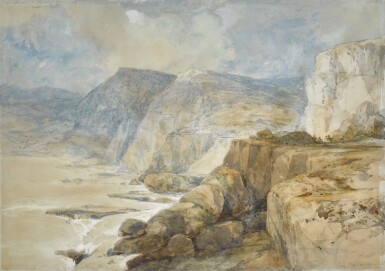The Orientalist Sale
The Orientalist Sale

David Roberts, R.A.
Cape Blanco, Lebanon
Lot Closed
October 26, 02:09 PM GMT
Estimate
8,000 - 12,000 GBP
Lot Details
Description
David Roberts, R.A.
Edinburgh 1796 - 1864 London
Cape Blanco, Lebanon
Watercolour over pencil, heightened with white; a pencil sketch of the island of Tyre verso,
the recto, inscribed and dated lower right: Cape Blanco April 26th / 1839, further inscribed upper left: ? el-Abiad. or the white promontory / coast of Syria.; numbered upper right: 216, the verso inscribed: No1 Tyre on the Island 2 remains of the Christian Church 3 ancient causeway connecting Tyre with the mainland 4 Ancient Tyre / The above sketch was taken on approaching Tyre from the South, and at about four miles off.
244 by 342 mm
Sale, Lewes, Gorringes, 8 March 2021, lot 1637 (as English School, 19th century)
Lithographed:
the preliminary sketch for Holy Land, 1843, Vol.II, [pl.67] with above title; 1855, vol. II, pl. 67, as Cape Blanco
This drawing, which Robert’s drew ‘on the spot’ during his iconic eleven month tour of the Holy Land in 1838/9 has only recently come to the attention of scholars. It shows the dramatic landscape of Râs el Bïyâda, which is situated north of Iskanndaroûna, close to Ouâdi Jisr el Khachab in Lebanon. It is particularly exciting as it seems to be the watercolour that the artist mentions in his travel journal:
‘We began to ascend Cape Blanco. The road is carried along the face of the rock at a most fearful height, and the sea washes its base with a tremendous surge. I could not resist stopping to make a coloured study of this pass. With the heavy clouds rolling above and the tremendous sea it was unquestionably the most sublime scene I had met with in Syria. Still keeping close to the sea, in about an hour and half we approached the fountains called the wells of Soloman. … An hour’s ride along the sands brought us in front of ancient Tyre or rather the ancient site of it. The plain is not of very great extent and is bordered on the East by low hills. Some remains of the ancient city still exist.’1
When Roberts arrived back in Britain in July 1839, he carried with him a portfolio that he felt was ‘one of the richest… that ever left the East’. It contained 272 drawings, ranging from studies of Egyptian temples and Islamic mosques, to Holy Land scenery. These drawings formed the basis for a series of lithographs which, between 1842 and 1849, were published under the title: The Holy Land, Syria, Idumea, Arabia, Egypt and Numbia. This book caused a sensation and secured forever Robert’s reputation as an intrepid traveler and one of the formost artists of his day.
Roberts included this view of Cape Blanco in his lithographic series, and the watercolour that he made when back in England (on which the print was based) is now held in the Museum of New Zealand Te Papa Tongarewa, Wellington, New Zealand (1957-0009-218).
We are grateful to Briony Llewellyn for her help when cataloguing.
1 Eastern Journal, 26 April 1839, NLS Acc 7723/2
